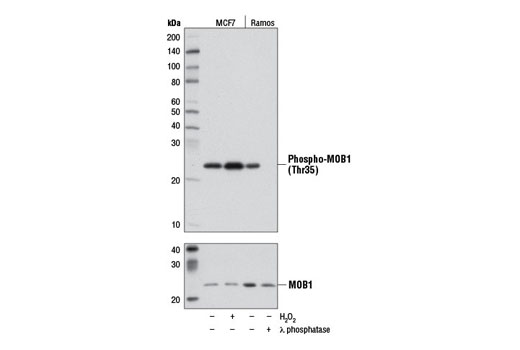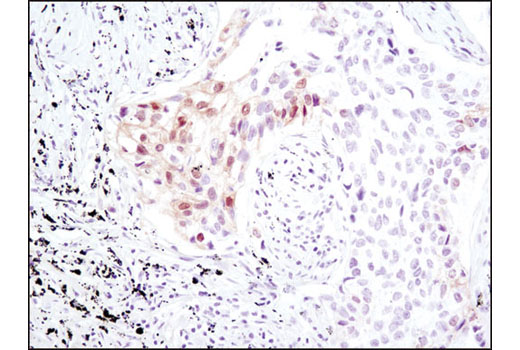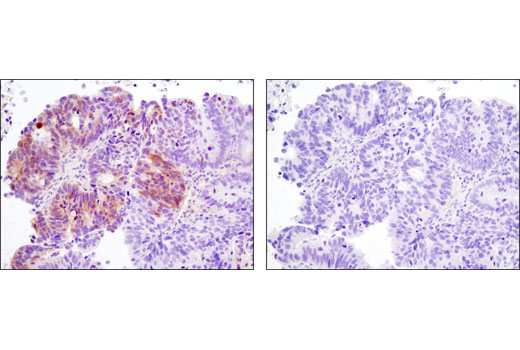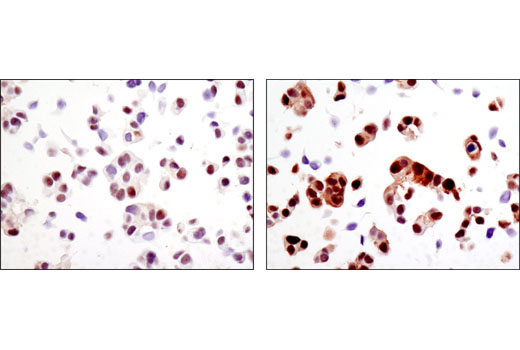WB, IHC-P
H M R Mk
Endogenous
24
Rabbit IgG
#Q9H8S9, #Q7L9L4
55233, 92597
Product Information
Product Usage Information
| Application | Dilution |
|---|---|
| Western Blotting | 1:1000 |
| Immunohistochemistry (Paraffin) | 1:50 |
Storage
Specificity / Sensitivity
Species Reactivity:
Human, Mouse, Rat, Monkey
Species predicted to react based on 100% sequence homology
The antigen sequence used to produce this antibody shares
100% sequence homology with the species listed here, but
reactivity has not been tested or confirmed to work by CST.
Use of this product with these species is not covered under
our
Product Performance Guarantee.
Hamster, Chicken, Xenopus, Zebrafish, Bovine, Horse, Guinea Pig
Source / Purification
Monoclonal antibody is produced by immunizing animals with a synthetic phosphopeptide corresponding to residues surrounding Thr35 of human MOB1 protein.
Background
MOB1 was first identified in yeast as a protein that binds to Mps with essential roles in the completion of mitosis and the maintenance of ploidy (1). Its Drosophila and mammalian homologs, Mats and MOB1, respectively, are involved in the Hippo signaling tumor suppressor pathway, which plays a critical role in organ size regulation and which has been implicated in cancer development (2-5). There are two MOB1 proteins in humans, MOB1A and MOB1B, that are encoded by two different genes but which have greater than 95% amino acid sequence identity (6). Both forms bind to members of the nuclear Dbf2-related (NDR) kinases, such as LATS1/2 and NDR1/2, thereby stimulating kinase activity (7-9). This binding is promoted by the phosphorylation of MOB1 at several threonine residues (e.g., Thr12, Thr35) by MST1 and/or MST2 (5,10).
Phosphorylation at Thr35 by MST1/2 stabilizes MOB1, enhancing its binding and regulation of LATS1 (5). The resultant increase in LATS1 kinase activity promotes inhibitory phosphorylation of the transcriptional co-activators YAP and TAZ (11,12), leading to changes in the expression of genes involved in cell cycle progression (13).
- Luca, F.C. and Winey, M. (1998) Mol Biol Cell 9, 29-46.
- Edgar, B.A. (2006) Cell 124, 267-73.
- Saucedo, L.J. and Edgar, B.A. (2007) Nat Rev Mol Cell Biol 8, 613-21.
- Harvey, K. and Tapon, N. (2007) Nat Rev Cancer 7, 182-91.
- Zeng, Q. and Hong, W. (2008) Cancer Cell 13, 188-92.
- Praskova, M. et al. (2008) Curr Biol 18, 311-21.
- Devroe, E. et al. (2004) J Biol Chem 279, 24444-51.
- Hergovich, A. et al. (2005) Mol Cell Biol 25, 8259-72.
- Hergovich, A. et al. (2006) Biochem Biophys Res Commun 345, 50-8.
- Hirabayashi, S. et al. (2008) Oncogene 27, 4281-92.
- Zhao, B. et al. (2007) Genes Dev 21, 2747-61.
- Lei, Q.Y. et al. (2008) Mol Cell Biol 28, 2426-36.
- Hao, Y. et al. (2008) J Biol Chem 283, 5496-509.
Species Reactivity
Species reactivity is determined by testing in at least one approved application (e.g., western blot).
Western Blot Buffer
IMPORTANT: For western blots, incubate membrane with diluted primary antibody in 5% w/v BSA, 1X TBS, 0.1% Tween® 20 at 4°C with gentle shaking, overnight.
Applications Key
WB: Western Blotting IHC-P: Immunohistochemistry (Paraffin)
Cross-Reactivity Key
H: human M: mouse R: rat Hm: hamster Mk: monkey Vir: virus Mi: mink C: chicken Dm: D. melanogaster X: Xenopus Z: zebrafish B: bovine Dg: dog Pg: pig Sc: S. cerevisiae Ce: C. elegans Hr: horse GP: Guinea Pig Rab: rabbit All: all species expected
Trademarks and Patents
使用に関する制限
法的な権限を与えられたCSTの担当者が署名した書面によって別途明示的に合意された場合を除き、 CST、その関連会社または代理店が提供する製品には以下の条件が適用されます。お客様が定める条件でここに定められた条件に含まれるものを超えるもの、 または、ここに定められた条件と異なるものは、法的な権限を与えられたCSTの担当者が別途書面にて受諾した場合を除き、拒絶され、 いかなる効力も効果も有しません。
研究専用 (For Research Use Only) またはこれに類似する表示がされた製品は、 いかなる目的についても FDA または外国もしくは国内のその他の規制機関により承認、認可または許可を受けていません。 お客様は製品を診断もしくは治療目的で使用してはならず、また、製品に表示された内容に違反する方法で使用してはなりません。 CST が販売または使用許諾する製品は、エンドユーザーであるお客様に対し、使途を研究および開発のみに限定して提供されるものです。 診断、予防もしくは治療目的で製品を使用することまたは製品を再販売 (単独であるか他の製品等の一部であるかを問いません) もしくはその他の商業的利用の目的で購入することについては、CST から別途許諾を得る必要があります。 お客様は以下の事項を遵守しなければなりません。(a) CST の製品 (単独であるか他の資材と一緒であるかを問いません) を販売、使用許諾、貸与、寄付もしくはその他の態様で第三者に譲渡したり使用させたりしてはなりません。また、商用の製品を製造するために CST の製品を使用してはなりません。(b) 複製、改変、リバースエンジニアリング、逆コンパイル、 分解または他の方法により製品の構造または技術を解明しようとしてはなりません。また、 CST の製品またはサービスと競合する製品またはサービスを開発する目的で CST の製品を使用してはなりません。(c) CST の製品の商標、商号、ロゴ、特許または著作権に関する通知または表示を除去したり改変したりしてはなりません。(d) CST の製品をCST 製品販売条件(CST’s Product Terms of Sale) および該当する書面のみに従って使用しなければなりません。(e) CST の製品に関連してお客様が使用する第三者の製品またはサービスに関する使用許諾条件、 サービス提供条件またはこれに類する合意事項を遵守しなければなりません。



